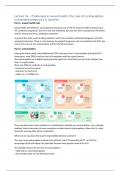Lecture 5a – Challenges in sexual health: the case of contraception,
unintended pregnancy & abortion
Part 1: sexual health risks
Sexual health risk behavior: sexual behavior that puts one at risk for adverse health outcomes (e.g.
STI, unwanted pregnancy), the risk is not only individual, but may also have consequences for others
and the environment (e.g. antibiotics resistance)
In general the dutch youth is doing relatively ‘well’ if you consider unintended pregnancy and STIs
unwanted outcomes. There is a low teenage (unwanted) pregnancy rate, low abortion rate (8,9), low
rate of non-users of any contraception and los HIV/STI prevalence.
Part 2: contraception
Among the Dutch youth, most adolescents (90%) used any form of contraception during first PIV-
intercourse, most (90%) used any form of conception with last sexual partner.
The contraception use is highest among females aged 16-24 and there are not much changes over
time, it is quite stable.
There are different methods of contraception:
- hormonal vs non-hormonal
- long term vs short term
- single use vs multiple use
There are discussions about whether or not behavioral methods are ‘contraceptives’ (e.g. calendar
method, coitus interruptus some researches include natural contraceptives, others don’t), what
about the morning after pill or an abortion?
What can we say about the shared responsibility between partners?
The most used contraceptive method is the pill 64%, and 11% spiraaltje (2017). In 2012 the
percentage of pill was higher, but spiraaltje became more popular (used to be 5%).
The possible reasons for non-use of contraceptives:
- Child wish or currently pregnant
- Not sexually active (or not PIV-intercourse)





